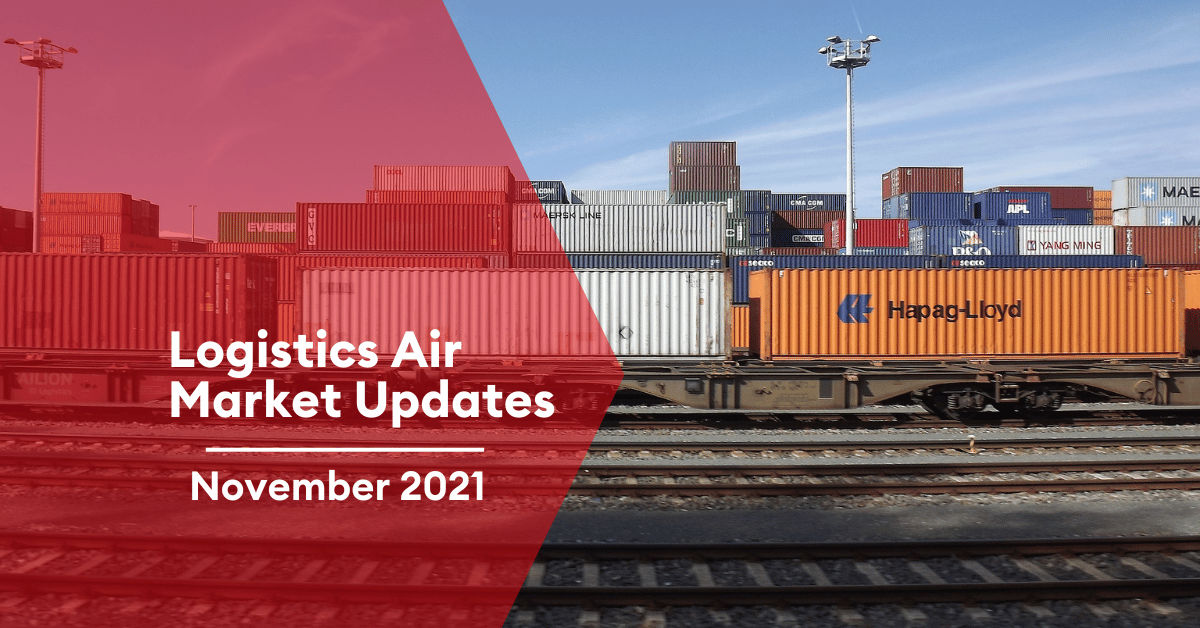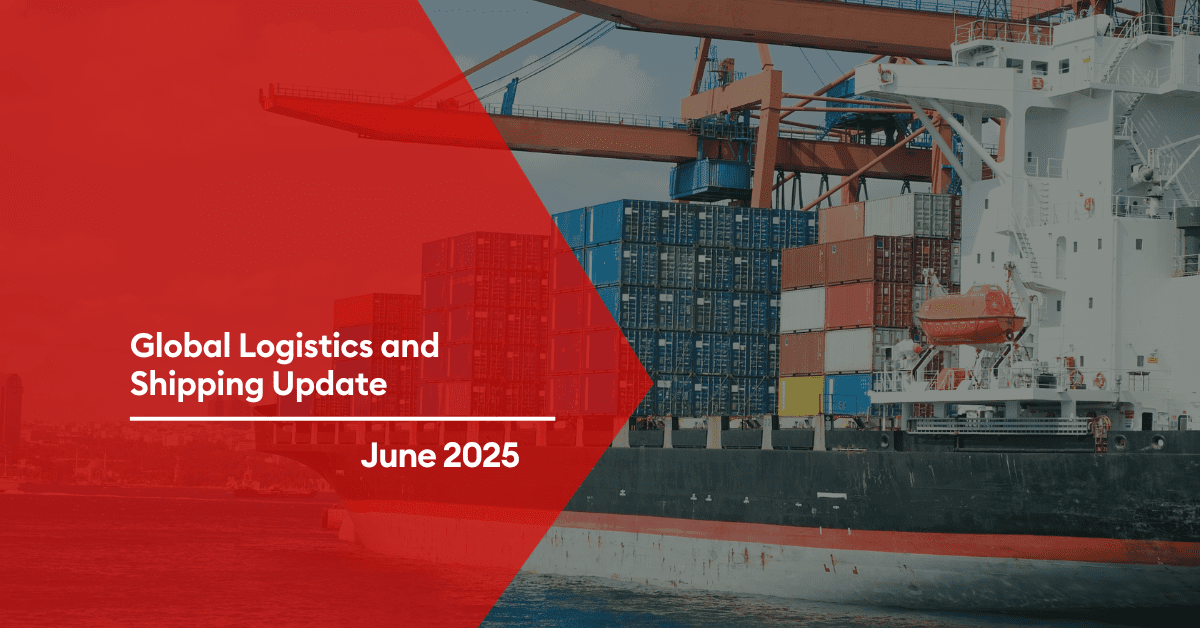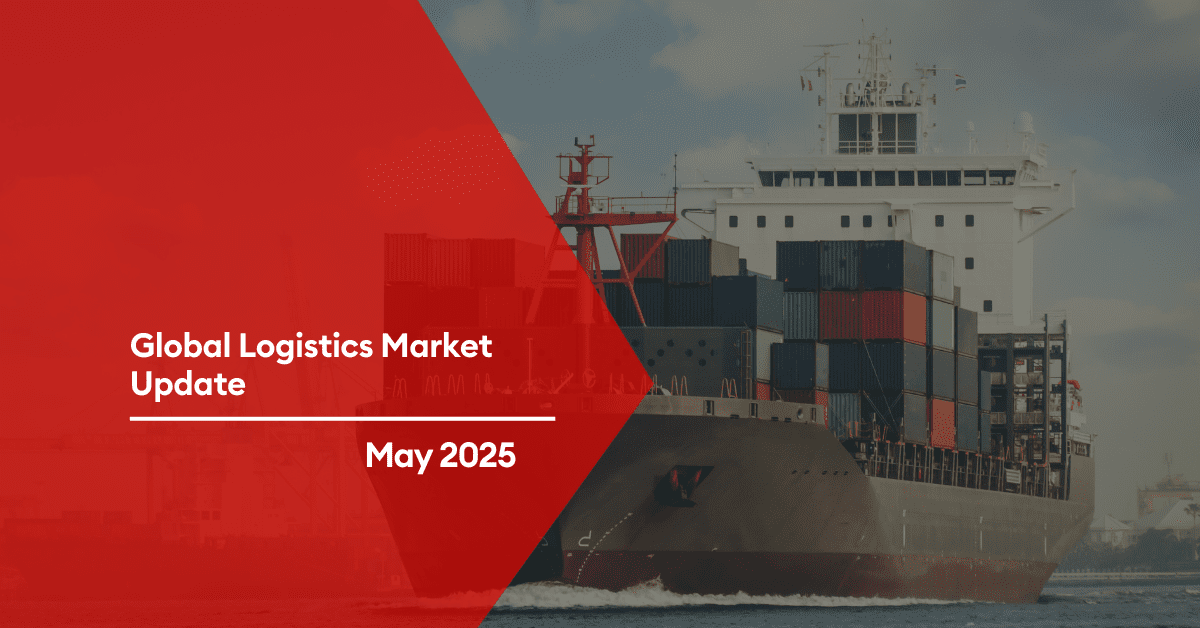
Al Sharqi November 2021 Ocean and Air Market Updates
Monthly Freight Market Updates
The Top Story of the Month
This month marks the beginning of the final stretch before the Christmas season. We are already seeing a little decline in the East-West Trade’s price high. Urgent or missed shipment dates from product suppliers would necessitate moving their items via “multimodal Sea-Air or just by Air” alone to arrive in time for their preferred retailer’s shelf.
With the current supply chain issue, shipping lines will jointly generate 130 billion dollars in profit, which will be used for diversification and M/A for the business, as witnessed with Maersk’s recent purchasing spree.
| Sign | Meaning |
| ++ | Strong Increase |
| + | Moderate Increase |
| = | No Changes |
| – | Moderate Decline |
| — | Strong Decline |
November 2021 United Arab Emirates Sea Freight Market Updates
The Ocean Outbound Updates

Middle East→ North America
One line Status High rate increases, limited capacity for interior-point intermodal (IPI) bookings, and carriers’ preference for port-to-port freight Advance reservations are strongly advised since space in Houston and on the West Coast of the United States is restricted to entirely unavailable. Spot prices are rising month over month, but capacity is remaining stable.
Local Rates Increased (+)
Local Space Very Critical (–)
Local capacity/Equipment Limited but available on selected carrier (-)
Notes: Bookings need to be made 3-4 weeks in advance
Middle East → Latin America
One line Status Spot rates have gone up month over month, due to congestion at transshipment ports. Carrier alternatives are confined to South America’s East and West Coasts, and huge volume reservations are particularly difficult. Month over month, capacity remains constant.
Local Rates The prices are increasing generally (++)
Local Space Very tight (–)
Local capacity/Equipment (-)
Notes: Bookings need to be made at least 4 weeks before
Middle East → Europe
One line Status Due to transshipment volumes from China/Far East via the UAE, there are space constraints. Space to the Eastern Mediterranean is more limited than to other locations, thus reserving ahead of time is advised. Spot prices are increasing month over month, but capacity is remaining stable.
Local Rates No increase since October 2021 (+)
Local Space Critical (-)
Local capacity/Equipment Equipment is available but reservations are restricted, but available on a premium on the specified carrier (-/=)
Notes: Bookings must be made 3-4 weeks in advance to secure
Middle East → Oceania
One line Status Congestion at South East Asian transshipment ports is triggering several weeks of transit delays. Space has become fairly available with prior booking, and spot costs have increased month over month. Capacity remains constant MoM.
Local Rates (+)
Local Space (-)
Local capacity/Equipment (–)
Notes: Bookings must be made at least 4 weeks before
Middle East → Africa
One line Status Space is limited, and 20′ standard and heavy cargo are much more so; as a result, many carriers have ceased reservations to West Africa. Direct routes are fully booked weeks in advance of their scheduled departure date, and overall schedule dependability remains a concern. Spot rates have gone up month over month.
Local Rates The prices are increasing generally (+)
Local Space Critical and low in West Africa, particularly in East Africa (-)
Local capacity/Equipment Limited available (-)
Notes: Maersk Spot is reserved for 2-3 weeks in advance, and goods using “Shipping Guarantee” are given priority.
Middle East → China
One line Status Costs have risen due to a shortage of equipment for items destined for Asia. While electricity shortages in some Chinese areas may limit output, demand remains extraordinarily strong.
Local Rates The prices are increasing generally (++)
Local Space Tight Space (-)
Local capacity/Equipment available (-/=)
Notes: Book 2-3 weeks ahead
Middle East → Mediterranean MED
One line Status Rates remain high. Space is constrained and only available at a premium price. Carrier preference is for lightweight freight.
Local Rates The prices are increasing generally (+)
Local Space Limited but at a premium (-)
Local capacity/Equipment available
Middle East → ISC (Intra-Gulf)
One line Status At Red Sea ports, there is a shortage of 20′ equipment. Rates have climbed since October 2021
Local Rates The prices are increasing generally (+)
Local Space available (-/=)
Local capacity/Equipment available
Notes: Bookings must be made at least 2-3 weeks in advance to ensure availability.
Middle East → Far East Asia
One line Status Schedules remain unstable due to deliberately decreased capacity caused by ships delayed in the Far East. Space is reasonably available, and spot rates and capacity have remained stable month over month.
Local Rates The prices are increasing generally (+)
Local Space Limited Space (-)
Local capacity/Equipment available (-/=)
Notes: Bookings must be made at least 2-3 weeks before
United Arab Emirates Inbound Ocean Market Updates November 2021
One line Status Port congestion, vacant sailings, and port omissions on a regular basis, and no room for export bookings for 4–5 weeks. Some carriers are discontinuing service to the Middle East in favor of Asia trade, notably on the West Coast of the United States. Spot prices are increasing month over month, while capacity is decreasing MoM.
Local Rates rates are trending up month over month (+).
Local Space Very Critical (-/=)
Local capacity/Equipment Capacity is trending down MoM (-)
Notes: Book 3-4 weeks before
Latin America
One line Status Due to the move to other trade routes, space is limited, demand is high, and equipment supply is constrained. Spot prices are increasing month over month, but capacity is remaining stable.
Local Rates Rate increases (+)
Local Space available (-)
Local capacity/Equipment -/(=)
Notes: Book 2-3 weeks before
Europe
One line Status Historically a backhaul service, space is largely available, although there is congestion at major European base ports. Lack of dray capacity in the UK, as well as a lack of equipment with Mediterranean origins, is progressively improving. Spot rates and capacity are unchanged month over month.
Local Rates Rates slightly increased (+)
Local Space Critical (-/=)
Local capacity/Equipment (-) remain the same since October 2021
Asia Pacific
One line Status- Limited service capacity and booking acceptance from carriers in Australia and New Zealand. Space is tight, with many blank sailings, and liners are unable to fill capacity shortages as assets are moved to other trades.
Local Rates increase (+)
Local Space very critical(–)
Local capacity/Equipment tight (-)
Notes: Book 2-3 week before
Indian SubContinent (ISC)
One line Status Because space is limited, reservations should be made in advance. Rate levels in Pakistan have risen, and spot rates are rising month over month. Capacity remains constant.
Local Rates Rates increase (+)
Local Space available (-)
Local capacity/Equipment (=)
Notes: Book 2 weeks ago
Air Cargo Updates to the United Arab Emirates November 2021
Air Freight Demand– Outbound demand from Europe was constant, but volumes from the Middle East grew. The volume of export cargo from Asia-Pacific has grown. The Covid problem may have an influence on demand in Southeast Asia and China in the coming months. Demand growth in all regions remained strong in 2021. Currently +5% (YTD Jul) above pre-pandemic levels; overall growth +21% YoY as of Aug 21. It is worth noting that the demand baseline for July and August 20 was boosted by PPE (personal proactive equipment) movements. In terms of the YTD July comparison, demand is +5% higher than in 2019. Congested ocean ports continue to increase air traffic, despite the fact that marine freight costs have declined slightly ahead of the Golden Week holiday.
Carrier Capacity – Capacity is still insufficient to satisfy current demand. Global capacity is still being hit, with a -22 percent drop since September of last year. The Delta variant’s return in China, Southeast Asia, and Europe is projected to have an influence on belly recovery. The rise in capacity in North America and Latin America has been driven by a significant intake of vaccines, but there are still backlogs and space constraints at the majority of North, Central, and South American (AMER) airports.
Local rate– Airlines continue to actively limit yields; extra capacity is still available for a fee. On August 21, rates were +86% higher than the 2019 baseline and +20% higher than the higher 2020 baseline. Rates will remain high as huge demand growth continues to outpace limited capacity. Rates to/from Asia Pacific (especially China) are expected to remain high due to ongoing constraints; market rates are around four times higher than the average.
US export demand increased in the second half of October. Larger shipments from major outbound gateways can take 2 to 4 days to be raised into Europe, Latin America, or Asia from the moment they are booked. Recommendation Plan ahead of time, taking into account the number of time passengers spend at airports.
Rising incidences around the globe, from North America to Asia and Latin America. Rates entering Europe have been quite stable. Because of the current labor shortage, top European hubs have somewhat longer transit times and a high throughput time. Ground handlers at LAX/ORD/JFK continue to have significant backlogs and are resorting to using off-airport facilities to manage the flood of inbound cargo, which has a knock-on effect on the export side. Many have lowered their storage free time and announced new, early export shutouts to accommodate higher throughput times and screening requirements.
Europe
So far, there have been no updates on Far East Eastbound. Capacity is still manageable. The ground handling terminals in Amsterdam and France are still under significant strain. Congestion at FRA terminals remains a concern. The AMS import terminals are outperforming the FRA.
Demand is expected to increase as we approach major holidays in November. Capacity, on the other hand, should enhance stability since vaccinated passengers may fly from the US to Europe. This is good news for freight capacity. The market this week has seen a surge in project cargo. The demand is high but manageable. JFK has seen a huge increase in demand, with direct flights completely sold out this week. As a result, interest rates on the United States East Coast have soared. Moving through a secondary hub may be advantageous if the journey time permits.
The advice is still in place for all trade routes leaving Europe: For the best rate and travel choices, book at least 7 days in advance of CRD.

Asia
The Bangkok market is still extremely tight, with no significant changes from the previous week. Ex-Northern Vietnam has steady demand and pricing, and some firms are working longer hours to create cargo. Demand in ex-Southern Vietnam is increasing, owing mostly to substantial accounts and charter requests ex-SGN (Ho Chi Minh City in Vietnam). Rates are still rising, and capacity is increasingly restricted. Throughout the weekend, all available space in SouthEast Asia is occupied.
As we approach the traditional peak season in Taiwan, the market remains tight and rates remain high. Capacity is practically fully booked through the end of the month, with demand particularly strong on the United States east coast. The first volumetric freight departures occur around the first week of November.
The market in North China has quickly recovered from the break and is back to its typical high season. As a result of continued cancellations by major carriers, rate levels are rising.
Demand exceeds supply, and capacity is constrained ex-HKG due to passenger flight cancellations. Other airlines have also announced flight cancellations. Rates on South China’s Trans-Pacific Eastbound (TPEB) and Far East Westbound (FEWB) lanes continue to grow.
The Middle East and Air Carriers ME
According to IATA, RPKs of Middle Eastern and African airlines fell by 68 percent and 58 percent, respectively, in August compared to August 2019. The traffic between the Middle East and North America has proven to be the most strong of the major regional routes.

The relaxation of COVID-related restrictions boosted economic activity in both Saudi Arabia and South Africa in September. The UAE’s economic boom slowed somewhat in September but remained favorable to corporate activity.
African airlines are forecast to get 35% more aircraft deliveries in 2022 than in 2021, while Middle Eastern airlines are likely to receive 44% more deliveries during the same time period. Nonetheless, the volume of deliveries in both categories is likely to be lower than in 2019.

United Arab Emirates Freight Local Updates, November 2021
November 2021 Logistics News Updates
- Freight Collect Information on MSC details of shipper and consignee must be informed to MSC at POD for approval on every collect shipment before the booking stage.
- ESL implemented an Overweight Surcharge (OWS) from the Indian Subcontinent and Arabian Gulf to East African ports. Read More Here
- ESL has imposed IMO 2020 Environmental Fuel Surcharge (EFS), Effective from 1st November 2021, based on a Low Sulphur Fuel price of between US$500 to US$550 per ton for October 2021. Read More Here
- Hamburg Sud has informed about their 24*7 Invoice Download Facility and payments solutions from ODEX. Read More Here
- Hapag Llyod has applied Weight Deviation Fee (FIO) for shipment of single and multi containers exceeding three tons between the booking and shipping instruction at a container level. Read More Here
- The China Navigation Company Ltd. (CNCO) has announced that it has been renamed Swire Shipping Ltd. (Swire Shipping). Read More Here
- KMTC has introduced the process of Web booking and BL submission through EKMTC Portal for real-time information such as schedule cargo tracking, booking records, B/L records, and so on. Read More Here
- ESL has published schedule and cargo tracking for East Africa Ports for securing transit time and minimizing the impact. Read More Here
- Hamburg Sud has decided to reroute all their vessels until the end of January 2022 from GBFXS to GBLGP due to the situation in Felixstowe and the high yard density. Read More Here
- Maersk has updated APMM Global operations, Maersk vessels in real-time and gained access to AI-powered predictive analysis and estimated times of arrival (ETA) via their Hub. Read More Here
- Hapag Lloyd has a new fresh look and new feature in their Quick Quotes Tool, available for use at their website.
- CMA CGM, with immediate effect sea priority Go (SPGO), will apply to all bookings made to East Africa from the UAE. There will be an increase in quantum effectiveness immediately. To know more about the quantum reach out to us Read More Here
November 2021 Factory Output News
Middle East

The UAE economy appears to be in good shape with the start of Expo 2020. The PMI decreased to 53.3 in September, but it still indicated a considerable improvement in non-oil business conditions, as firms perceived recovery in demand following the pandemic. The loosening of global travel limitations aided in the growth of new enterprises.
America
If consumer spending on services, business investment, and exports continues to expand, real GDP is predicted to rise 2.8 percent in 2023 and 2.7 percent in 2024. The forecast assumes the passage of the Infrastructure Investment and Jobs Act but not the Build Back Better reconciliation package, which contains major increases in social expenditure and taxation.
Concerns about COVID-19 and growing supply limitations may cause some US growth to be delayed beyond 2021. Real GDP growth in 2021 has been cut by 0.3 percentage points to 5.4 percent, and by 0.2 percentage points to 4.3 percent in 2022. Slower consumer spending, less light car assembly, and abysmal third-quarter exports all contribute to the changes. On the plus side, a solid September retail sales figure implies that consumers are still ready to spend as COVID-19 virus infections decline.
Europe
A scarcity of electrical components and raw materials is impeding production. In the meanwhile, demand is decreasing as high inflation cuts real family wages. Real GDP in the Eurozone is predicted to increase by 5.0 percent in 2021, 4.0 percent in 2022, and 2.2 percent in 2023. While the chances for development in Emerging Europe are marginally better, near-term growth is hampered by fresh COVID-19 cases in a number of economies, most notably Russia, Romania, and the Baltic States.
The economic boom in Western Europe that began in mid-2021 is subsiding, and input shortages are constraining productivity. With the removal of pandemic-related constraints, real GDP is likely to rise at a respectable rate in Q3, fueled by consumer spending.
Asia
Taiwan Semiconductor Manufacturing Co. has agreed to give logistical information to the US government by November 8th in order to help resolve semiconductor supply difficulties.
SME agriculture firms in Singapore are increasing to reduce reliance on imported food.
Vietnam‘s labor problem continues to jeopardize the country’s logistics.
Infestation of the Indian Pink Bollworm has resulted in a loss of up to 76 percent of cotton yield in India’s important cotton-growing regions of Bathinda and Mansa.
Pakistan‘s energy supply may be jeopardized as a result of port congestion.
The Mainland Chinese economy is being hampered by the real estate slump and power shortages. In September, industrial output growth fell to 3.1 percent year on year, down from 5.3 percent in August, with energy-intensive commodities such as metals, chemicals, and construction materials taking the brunt of the impact. Coal-based thermal power, which accounts for 70% of the country’s electrical generation, has been affected by Beijing’s decarbonization initiatives, as well as the end of Australian coal imports in 2021. Meanwhile, the government’s deleveraging campaign targeting real estate developers is dampening real estate and construction activity.

Exciting News This Month
- China’s Energy Crisis Is Hitting Everything From iPhones to Milk [Read More Here]
- LaserShip, OnTrac deal sets regional parcel carriers up as FedEx, UPS alternatives [Read More Here]
- No more room at the logistics warehouse in, Prologis says – FreightWaves [Read More Here]
- Plans call for McAlary to start in the chief legal officer post on Nov. 15 [Read More Here]
- Snowcone the Happy Unicorn is the latest victim of manufacturing chaos [Read More Here]
- Target goes down the vessel chartering path taken by Walmart, Home Depot, and Costco [Read More Here]
- Supply Chain: Industry looks beyond Asia for sourcing – Furniture Today [Read More Here]
- Global trade rebound beats expectations but marked by regional divergences [Read More Here]
- China’s export advantage is being squeezed by soaring sea freight prices and rising raw material costs | South China Morning Post [Read More Here]
- SoftBank-backed Flock Freight is the freight industry’s newest unicorn [Read Morte Here]
- Procter & Gamble Uses Its Size to Lessen Impact of Supply-Chain Mess -[Read More Here]
- Big Retailers Becoming Big Property Owners With Warehouse Deals -[Read More Here]
- Spending on Halloween candy is projected to be up a spooktacular 10% [Read More Here]
- Why the supply chain crunch will continue into 2022 [Read More]
- Transportation executives wrestling with the supply-chain gridlock that is frustrating [Read More Here]
- Industry Short 80,000 Drivers Today, May Be Short 160,000 by 2030 [Read More Here]
- Dedicated business booms for fleets as shippers avoid the pricey spot market [Read More Here]
- Supply chain cybersecurity breaches have hit an alarming percentage of firms [Read More Here]
- Peak shipping season can be broken down into two spikes in demand.{Read More Here]
- Tighter Warehouse Space Adds to the Supply-Chain Squeeze [Read More Here]
- Shippers Find New Supply-Chain Hurdles at Alternate Ports [Read More Here]
- Retailers say the levies on containers stuck at terminals will end up hitting powerless freight customers [Read More Here]
- Home Depot hires Walmart delivery drivers to drop off paint and more to customers’ doors [Read More Here]
Related Articles
July 2025 Global Freight & Supply Chain
Middle East Ocean Freight and Port Operations Stable Operations with Ongoing Risk Monitoring Ocean f
Global Logistics and Shipping Update – June 2025
U.S. Revised Port Fee Regulations Impacting Chinese Maritime and Logistics Sectors The U.S. Trade Re
Global Logistics Market Update – May 2025
New Sulphur Emission Limits Enter into Effect in the Mediterranean The Mediterranean Sea officially







Post a comment
You must be logged in to post a comment.